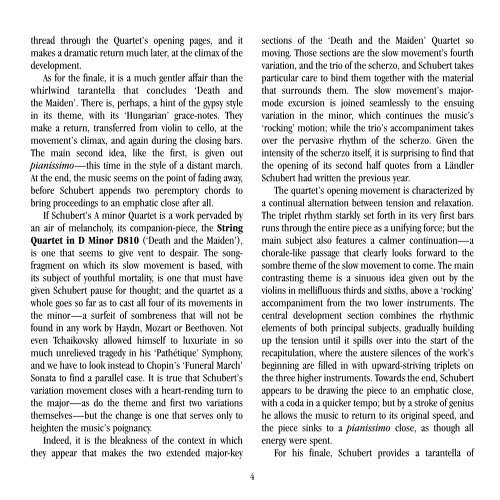Téléchargez le livret intégral en format PDF ... - Abeille Musique
Téléchargez le livret intégral en format PDF ... - Abeille Musique
Téléchargez le livret intégral en format PDF ... - Abeille Musique
You also want an ePaper? Increase the reach of your titles
YUMPU automatically turns print PDFs into web optimized ePapers that Google loves.
thread through the Quartet’s op<strong>en</strong>ing pages, and it<br />
makes a dramatic return much later, at the climax of the<br />
developm<strong>en</strong>t.<br />
As for the fina<strong>le</strong>, it is a much g<strong>en</strong>t<strong>le</strong>r affair than the<br />
whirlwind tarantella that concludes ‘Death and<br />
the Maid<strong>en</strong>’. There is, perhaps, a hint of the gypsy sty<strong>le</strong><br />
in its theme, with its ‘Hungarian’ grace-notes. They<br />
make a return, transferred from violin to cello, at the<br />
movem<strong>en</strong>t’s climax, and again during the closing bars.<br />
The main second idea, like the first, is giv<strong>en</strong> out<br />
pianissimo—this time in the sty<strong>le</strong> of a distant march.<br />
At the <strong>en</strong>d, the music seems on the point of fading away,<br />
before Schubert app<strong>en</strong>ds two peremptory chords to<br />
bring proceedings to an emphatic close after all.<br />
If Schubert’s A minor Quartet is a work pervaded by<br />
an air of melancholy, its companion-piece, the String<br />
Quartet in D Minor D810 (‘Death and the Maid<strong>en</strong>’),<br />
is one that seems to give v<strong>en</strong>t to despair. The songfragm<strong>en</strong>t<br />
on which its slow movem<strong>en</strong>t is based, with<br />
its subject of youthful mortality, is one that must have<br />
giv<strong>en</strong> Schubert pause for thought; and the quartet as a<br />
who<strong>le</strong> goes so far as to cast all four of its movem<strong>en</strong>ts in<br />
the minor—a surfeit of sombr<strong>en</strong>ess that will not be<br />
found in any work by Haydn, Mozart or Beethov<strong>en</strong>. Not<br />
ev<strong>en</strong> Tchaikovsky allowed himself to luxuriate in so<br />
much unrelieved tragedy in his ‘Pathétique’ Symphony,<br />
and we have to look instead to Chopin’s ‘Funeral March’<br />
Sonata to find a paral<strong>le</strong>l case. It is true that Schubert’s<br />
variation movem<strong>en</strong>t closes with a heart-r<strong>en</strong>ding turn to<br />
the major—as do the theme and first two variations<br />
themselves—but the change is one that serves only to<br />
height<strong>en</strong> the music’s poignancy.<br />
Indeed, it is the b<strong>le</strong>akness of the context in which<br />
they appear that makes the two ext<strong>en</strong>ded major-key<br />
sections of the ‘Death and the Maid<strong>en</strong>’ Quartet so<br />
moving. Those sections are the slow movem<strong>en</strong>t’s fourth<br />
variation, and the trio of the scherzo, and Schubert takes<br />
particular care to bind them together with the material<br />
that surrounds them. The slow movem<strong>en</strong>t’s majormode<br />
excursion is joined seam<strong>le</strong>ssly to the <strong>en</strong>suing<br />
variation in the minor, which continues the music’s<br />
‘rocking’ motion; whi<strong>le</strong> the trio’s accompanim<strong>en</strong>t takes<br />
over the pervasive rhythm of the scherzo. Giv<strong>en</strong> the<br />
int<strong>en</strong>sity of the scherzo itself, it is surprising to find that<br />
the op<strong>en</strong>ing of its second half quotes from a Länd<strong>le</strong>r<br />
Schubert had writt<strong>en</strong> the previous year.<br />
The quartet’s op<strong>en</strong>ing movem<strong>en</strong>t is characterized by<br />
a continual alternation betwe<strong>en</strong> t<strong>en</strong>sion and relaxation.<br />
The trip<strong>le</strong>t rhythm starkly set forth in its very first bars<br />
runs through the <strong>en</strong>tire piece as a unifying force; but the<br />
main subject also features a calmer continuation—a<br />
chora<strong>le</strong>-like passage that c<strong>le</strong>arly looks forward to the<br />
sombre theme of the slow movem<strong>en</strong>t to come. The main<br />
contrasting theme is a sinuous idea giv<strong>en</strong> out by the<br />
violins in mellifluous thirds and sixths, above a ‘rocking’<br />
accompanim<strong>en</strong>t from the two lower instrum<strong>en</strong>ts. The<br />
c<strong>en</strong>tral developm<strong>en</strong>t section combines the rhythmic<br />
e<strong>le</strong>m<strong>en</strong>ts of both principal subjects, gradually building<br />
up the t<strong>en</strong>sion until it spills over into the start of the<br />
recapitulation, where the austere si<strong>le</strong>nces of the work’s<br />
beginning are fil<strong>le</strong>d in with upward-striving trip<strong>le</strong>ts on<br />
the three higher instrum<strong>en</strong>ts. Towards the <strong>en</strong>d, Schubert<br />
appears to be drawing the piece to an emphatic close,<br />
with a coda in a quicker tempo; but by a stroke of g<strong>en</strong>ius<br />
he allows the music to return to its original speed, and<br />
the piece sinks to a pianissimo close, as though all<br />
<strong>en</strong>ergy were sp<strong>en</strong>t.<br />
For his fina<strong>le</strong>, Schubert provides a tarantella of<br />
4
















